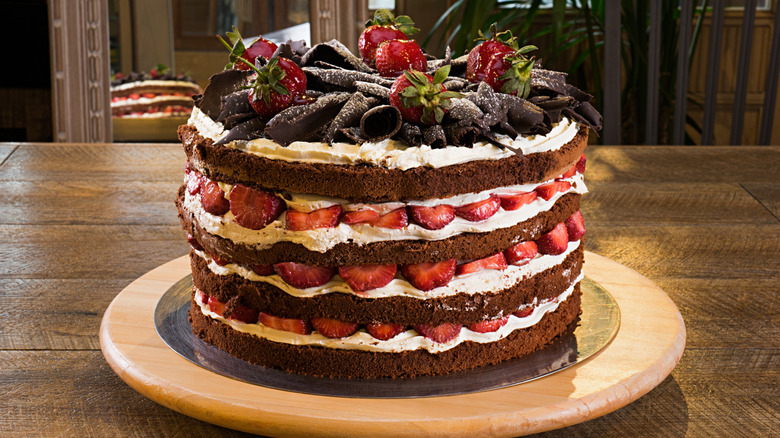What's The Difference Between Naked And Semi-Naked Cakes?
We may receive a commission on purchases made from links.
Layered cake recipes are delicious treats as much as they are showstopping centerpieces. But loading 'em up with heavy buttercream, too-crunchy edible pearls, and strips of ribbon can be overkill and gaudy. For a more understated aesthetic, many bakers have been exercising sophisticated restraint and opting for naked and semi-naked cakes.
The difference between these cake styles is largely what a foodie might expect: Naked cakes have no frosting at all, letting exposed layers of cake and buttercream filling speak for themselves. This rustic look is often adorned with cheerful fresh flowers and fresh fruit positioned on top of the cake.
Semi-naked cakes are smeared with a thin, translucent layer of frosting with exposed cake showing through. The small amount of frosting is typically applied using a spatula. (If you're new to this, buying baking kit online is useful here: This offset spatula set and pastry bench scraper will be handy, and this rotating turntable is wildly helpful at this step.) These techniques are typically employed with layer cakes, providing a subtle yet impressive visual for these vertically-towering treats. The semi-naked cake trend has dominated Pinterest on the wedding cake scene, a foodie favorite for its refined yet low-key vibe, like a strategically weathered, distressed paint look.
While an element of technique is certainly involved, naked and semi-naked cakes can be forgiving in their own way for decorators. There's no need to sweat over nailing a perfectly even, totally smooth buttercream exterior. So, if frosting isn't your technical specialty — or your taste preference — it might be time to consider going at least partially naked.
To frost or not to frost your cake? That is the question
To assemble a naked or semi-naked cake, the layers are constructed as normal. The first layer of cake is placed on the stand, topped with a layer of filling, then the next cake is stacked on top, repeating until complete. Since naked and semi-naked cakes don't have a forgiving buttercream exterior to hide beneath, it's especially important that these layers are neat in appearance. Domed tops should be shaved flat, and be sure not to skimp on the lush filling between the layers for clear definition; any gaps should be filled in with buttercream in a piping bag afterwards. Particularly when building semi-naked cakes, a crucial design element is contrast. Opt for dark cake with light filling or light cake with dark filling, so the layered visual won't disappear beneath the see-through buttercream coating.
Beyond tasting sweet and looking nice, frosting also serves a functional purpose for layer cakes: It helps lock in moisture, keeping the cake fresher longer and preventing it from drying out. This utility can be especially important during weddings and other events in which a cake might be sitting out uncovered for multiple hours. If you're preparing a naked or semi-naked cake for such an occasion, it should be assembled as close to the intended serving time as possible. Alternatively, some bakers choose to brush their naked cakes with a clear glaze to lock in moisture while still maintaining the naked aesthetic.

